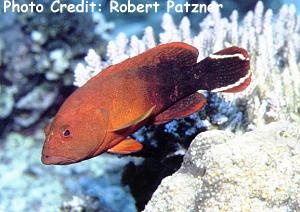
By Bob Goemans

Likely Reef Tank Suitable
Likely Fish-Only Tank Suitable
Range: Indo-West Pacific Ocean: Kenya to northern South Africa and eastward to French Polynesia and the Pitcairn Group.
Size: 11 inches (27 cm)
Natural Environment: Inhabits shallow lagoons, and back-reef areas where it’s usually found at depths between 10 – 50 feet (3 – 15 m), where it feeds on small fishes and crustaceans.
General Husbandry: Rarely seen in the trade, having a mottled reddish-orange body.
Can be maintained in ‘large’ reef or fish-only aquariums with several caves and ledges. May initially be somewhat shy, but will become more social in the coming weeks. Overall, somewhat peaceful, but will protect/chase away from what it considers its territory/areas in the aquarium. Will consume smaller tankmates.
As to diet, these are carnivores and require a diet high in protein and amino acids (lipids/fats). Products such as marine fish and crustacean flesh, clams, and other marine meaty foods should make up the majority of their diet. Therefore a meaty diet such as enriched chopped fresh fish or shrimp flesh, and/or frozen carnivore foods should be fed. And because these are not overly active fish, their metabolism is somewhat low, so feeding once every other day should suffice nicely.
May be difficult to feed in the early days in the aquarium and if so, (if small live marine fish are not available) live glass/grass shrimp and/or small crabs, e.g., fiddler crabs may be needed to sustain the fish.
Taxonomy:
Order: Perciformes
Suborder: Percoidei
Family: Serranidae
Subfamily: Epinephelinae
Genus: Cephalopholis
FYI: Human food fish in some local areas.
Not safe with smaller fishes, crabs, and small ornamental crustaceans.
Will usually stay near areas offering protection, i.e., caves and ledges.
One per aquarium.
Enhanced filtration is recommended as these fish produce a large amount of waste products.
As to live foods, occasional small live mollies and/or guppies can provide for that natural feeding excitement found in the wild should live marine fish not be available. Nevertheless, feeding small freshwater live fish should be considered a special treat and not become a steady diet since they lack the fatty acids that marine fish need to stay healthy.
Also, keep in mind that feeder goldfish, which cannot survive but a few minutes in seawater, also carry many different bacteria, fungi, and protozoa that can cause parasitic and infectious diseases. Furthermore, feeder goldfish can also cause blockage in the digestive track and/or kidney along with liver damage due to fatty degeneration in the consuming fish. And this will ultimately lead to the consumer’s death. In fact, fatty liver degeneration is a common cause of death in cases where marine fish are fed a diet that primarily consists of goldfish (as with Lionfish for example). Also, its possible the large air bladder in the goldfish can upset the internal balance in this fish, sometimes causing it to float at the surface, possibly killing it.
Experience Level: Intermediate
Temperament: Peaceful (will eat smaller fish and crustaceans)
Diet: Carnivore
Coral Safe: Yes
Fish Safe: With caution
Invertebrate Safe: With caution
Acclimation Time: 30 minutes+
Aquarium Environment: Reef or fish-only aquarium
Tankmates: Peaceful
Minimum Tank Size: 150+ gallons
Temperature Range: 72 - 82°F (22 – 28°C)
Specific Gravity: 1.020 - 1.026
pH: 8.0 - 8.5
